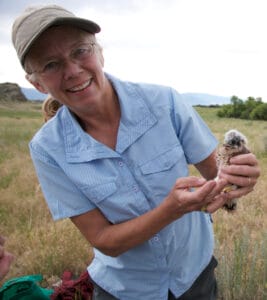Paulette Epple grew up on a game farm in Minnesota where her father raised ducks, geese, and peacocks, which were then sold to adorn zoos and private estates. So it was perhaps no surprise that after moving to Montana 40 years ago, she eventually found her way back to the avian world.
“As our kids grew up, I had more free time and got increasingly involved with Audubon,” she says over the phone, referring to the bird protection organization.

Paulette Epple holds a baby American kestrel. Photo: courtesy of Paulette Epple
A landscape designer specializing in native plants, Paulette is an avid birder who serves as conservation chair of Sacajawea Audubon Society in southwest Montana. Through her volunteer work, she emphasizes the importance of planting native shrubs and trees, whose berries, seeds, and insect inhabitants attract birds.
When she is not promoting bird-friendly habitats, Paulette is out searching for birds, with a good pair of binoculars (and often her husband) in tow. But in recent years, she has watched as real estate developers have descended on Montana to create subdivisions—destroying the habitats and wild landscapes that she and fellow birders have come to treasure.
One favorite birding spot that enjoys protection from development—and is a mere 15-minute drive from her home in Bozeman—is Chestnut Mountain. With beautiful views of the Gallatin Valley, a popular trail there moves through a variety of habitats, from open meadow to aspen groves to the edge of the timberline. At each elevation during the 2,000-foot hike, different birds come into focus.
“In June, July, and August, it’s breeding season and, on that trail, we usually start off seeing American dippers—songbirds that live in creeks,” she explains. (The use of “in” isn’t a mistake; these birds literally walk underwater, hunting for aquatic larvae.) “We’ll also spot yellow warblers floating around in the willows by the creek’s edge. Climbing higher, there are Calliope hummingbirds and Swainson’s thrushes. As we ascend into rocky cliffs, we see violet-green swallows, Canada jays, and Clark’s nutcrackers.”
In 2010, Trust for Public Land and its partners capped a multiyear effort to protect 2,055 acres, including part of Chestnut Mountain, the gateway to Bozeman Pass. The landmark project included a series of land purchases and conservation easements, as well as creation of the nonmotorized Chestnut Mountain and Frog Rock Trails. More conservation projects are planned for the state.
Join us to support TPL’s work in Montana and across the nation.
For Paulette, conserving natural landscapes in and around the growing city of Bozeman is vitally important. The city’s population has nearly doubled in the past twenty years, and during the pandemic those pressures intensified. According to a report from the California Policy Lab, a research group at the University of California, more people moved from San Francisco to Montana over the past two years than to any other state.
Land protection projects like the ones undertaken by Trust for Public Land not only preserve the state’s wild character: they also safeguard habitats for wildlife, including birds and mammals.
“The whole Bozeman Pass area is one of the only connectors between the central Rocky Mountains and the northern Rocky Mountains,” says Epple. “It provides an important pass-through for grizzly bears and cougars, as well as habitat for big, charismatic birds like great gray owls, which need a lot of territory for breeding.”
“We have a burgeoning community right now,” she adds. “Everybody wants to move to Montana because you can work virtually now. And there is a lot of demand being put on our trails.”
All the more reason to protect what land we can, while we can, so Montanans—current and future—have room to spread out and enjoy the landscape, much like the great gray owl.
Lisa W. Foderaro is a senior writer and researcher for Trust for Public Land. Previously, she was a reporter for the New York Times, where she covered parks and the environment.
This raw, beautiful landscape in Southern California is home to Indigenous heritage sites, and it provides critical habitat for threatened and endangered species. Urge the administration to safeguard this extraordinary landscape today!

